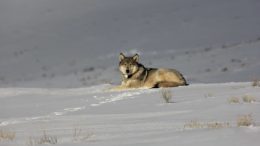This November voters in Colorado will get a chance to do something historic: vote on a ballot measure that proposes the reintroduction of gray wolves into the wilds of their state.
It’s the first time the question of reintroducing an endangered species has been placed in the public’s hands at the ballot box.
With or without a public vote, wolves seem to be reintroducing themselves: Last month Colorado Parks and Wildlife confirmed that a pack of six wolves has settled in the state for the first time in 80 years. But they’ll need political support to thrive there.
And an official reintroduction program could take wolves’ return further by encouraging the state to establish additional populations by the end of 2023. Proponents believe it could be a big ecological boost for Colorado, and they point to Yellowstone as proof.
Gray wolves were reintroduced in the national park 25 years ago, and the results were overwhelmingly positive. The wolves trimmed deer and elk populations, which had over-browsed vegetation. Riparian areas flourished again and attracted songbirds, beavers, foxes and other animals. It was proof that bringing a top predator back into an ecosystem has a beneficial ripple effect.
We spoke with University of Colorado Boulder ecology professor Joanna Lambert about the science of wolf reintroduction and what previous efforts have taught us about coexisting with apex predators as they recolonize a landscape.

What are the ecological arguments for returning wolves to Colorado?
Gray wolves evolved in North America, probably somewhere in western Alaska about 800,000 years ago. There were a lot of wolf species in North America and Eurasia at that time. The one that prevailed is the one that we know today as Canis lupus.
They dispersed throughout North America, and in so doing, they evolved alongside all of the other species that were there — all of their prey species, and all of the plant species that their prey were eating. But as a result of the concerted effort by the federal government to remove these apex predators that co-evolved over hundreds of thousands of years, the ecological interactions have been knocked out of balance.
We have huge populations of whitetail deer, mule deer and elk that can be a real issue. We saw that with thousands of elk in the northern parts of Yellowstone that the National Park Service had to cull every year. Over the decades, upwards of 75,000 elk were removed by the National Park Service before wolves were put back in.
So the argument is that by putting back in wolves — an apex predator that has evolved alongside their prey species — we’re putting things back into ecological balance.
Is this the first time that the public will vote on a ballot measure to determine whether an endangered species will be reintroduced?
It is and that’s why this is such a profound moment if it does pass.
And if it does — I’m not advocating one way or another — the conversation doesn’t end there. Colorado Parks and Wildlife Commission would then have to officially request a permit from U.S. Fish and Wildlife. This is all outlined in section 10 of the Endangered Species Act.
Ultimately this will be a conversation among scientists. And the scientists will determine where the wolves would be reintroduced. How to do it and where to do it will not be mandated or dictated by citizens, who aren’t trained in ecology. What we do know is that there are vast tracts of public lands in the form of national forest and BLM lands throughout the western slope of Colorado. There’s ample room for wolves.
Because gray wolves are an endangered species, we can think of this as another tool in the toolbox of conservation measures. But because this is a measure about wolves, people have extremely strong opinions one way or another. I think that’s adding to the significance of this. There have been several surveys, and one that just went online indicates over 80% of Colorado citizens want this measure to go through.
What is the opposition’s point of view?
Certainly there are folks that don’t want it. Very similar issues that arose in the greater Yellowstone ecosystem are occurring here, namely stakeholders from the ranching industry have concerns. It’s not an insignificant thing to have an apex predator suddenly put back into a system.
There are myriad ecological benefits, but there will be some costs, and those ranchers who have a permit to graze their cattle on public lands will lose some cattle for sure. Ignoring that fact would be naive.
The good news is that there’s language in the initiative to address that directly. And in addition to that, we’ve learned a lot already from wolf reintroduction in the greater Yellowstone ecosystem. A tremendous amount of knowledge exists on how to ranch with wolves and grizzly bears.
What we’re all hoping for is a landscape where we can coexist with the species that were originally here, but also acknowledging that humans need to make a living and that the costs of this initiative will be felt by some folks more than others.
But humans evolved alongside large-bodied predators, and we have had livestock alongside them for hundreds and hundreds of years. We can regain that knowledge. There are other examples from Europe where livestock owners are learning how to live with wolves. People are learning how to use guard dogs and increase vigilance. There are some fairly simple things that we can do.
If we’re not just going to kill everything that comes into our backyard or kill everything that comes into our rangeland, then we’ve got to learn how to live with them and how to seek mechanisms of coexistence, and I think we can do it.
Is the reintroduction effort in Yellowstone a primary model, or other areas guiding planning on how wolves could be reintroduced in Colorado?
In terms of just scientific documentation, Yellowstone has received the most attention because it was wildly successful. Wolves did incredibly well and they started dispersing out of Yellowstone at a rate that no one expected.
But that’s not the only place. Since 2000 we’ve had, globally, over 200 reintroduction initiatives of predators back into their native habitat. So this has been done elsewhere for sure, including in Africa where cheetahs are being put back into areas. We’ve got a lot to rest this on it — it has been done not just in Yellowstone but around the world.
What’s most exciting to you about wolves?
I have a yearning for wild places and wild things. And I have a yearning for putting things back together again. Humans have transformed this planet into a system that we view as just serving us. And in so doing, we have dismantled ecosystems and native species assemblages.
There’s a lot of grief around the world about what we’ve done. In fact, this has been documented in a phenomenon known as ecological grief. As we lose wild places, the very landscapes that we ourselves evolved in, we are feeling the emotional burden.
I guess that’s how I view this initiative: It’s a way of rewilding. It’s rewilding landscapes and putting a wild thing back into a wild place that used to be there, but that we’ve lost in the last hundred years because of unchecked human growth.
![]()



1 thought on “Will Voters Welcome Wolves Back to Colorado?”
Comments are closed.